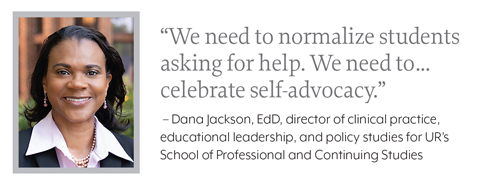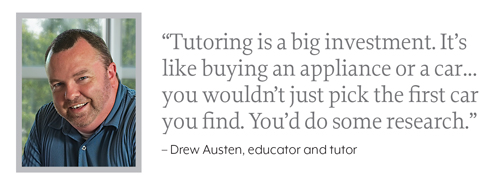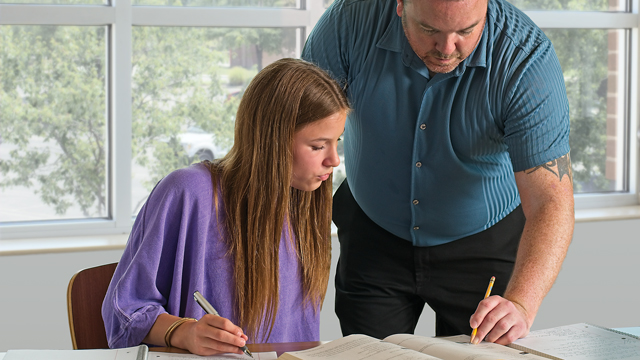Tutoring, like clothing, comes in all shapes and sizes.
For some people, tutoring might spark memories of frustration or embarrassment over struggling to understand a particular concept. For others, tutoring might have led to that a-ha moment – the proverbial light bulb going off over the head – and a breakthrough that makes all the difference going forward. For parents of students struggling with an academic subject, tutoring might generate worry over how to pay for additional instruction alongside a desire to do what’s best for their children.
Like clothing, for tutoring to work most effectively, it’s important to find the right fit.
Why Tutoring?
Tutoring – teaching delivered in one-on-one or small group settings – is nothing new. If a child is enrolled in a school, whether public or private, the teacher presents the curriculum to the entire class. A student might ask a question in class or come in at the start of the school day for additional assistance, but for the most part, the instruction offered is in a group setting. A tutor can help fill the gap between what’s available in school and what a student needs. And as students recover from interrupted learning due to the COVID-19 pandemic, tutoring is more relevant than ever.
“Parents typically pursue tutoring for two reasons: to review and reinforce foundational skills, and for one-on-one opportunity for enrichment,” says Dana Jackson, EdD, an assistant professor of education at the University of Richmond and director of clinical practice, educational leadership, and policy studies for UR’s School of Professional and Continuing Studies.
The first step is determining if, and where, tutoring can be useful.
According to Jackson, it’s important to start conversations with children early in the education process. “Younger children might not be able to articulate ‘Mom, I’m not strong in reading comprehension,’ but they are able to communicate some things to us, such as when something doesn’t feel right to them or they aren’t feeling confident,” she says. “We want to help them learn to self-regulate and talk about what they’re feeling.”
Parents also need to pay attention to what their children are doing in school, Jackson adds.
“Review their assessments, analyze their progress through the lens of grade expectations,” she says. “The learning team can support you to review your child’s learning successes and growth. Where did they start, and where are they now? Are they on a path for continuous improvement?”

It’s also wise to talk with the teacher directly.
“Our children are our greatest investment, so make some time to talk with the teacher and build the relationship,” Jackson says. “Monitor what’s coming home and monitor grades. You’ll get a good sense of what’s happening.”
Patrice Wilson, PhD, principal of Bensley Elementary School in Chesterfield County, agrees that for caregivers, paying attention is a baseline requirement.
“Parents need to observe their child,” she says. “You never want a child to get to the frustration level where they’re crying or upset.
“We are responsible for our child’s growth in education,” Wilson adds. “Parents should hold themselves accountable for their child’s success in education.”
Wilson says if problems arise, the teacher should be the first point of contact, because the teacher is familiar with the student and also knows who else within the school might be able to offer assistance, such as subject-specific intervention. Schools with a high percentage of students from socioeconomically disadvantaged families have Title I designation and receive federal funding on top of state funding, allowing for additional help that might not be available at home.
Bensley Elementary – recognized twice as a National Title I Distinguished School – has funding for extra staffing, instructional materials, and professional learning opportunities. During the day, blocks of time are set aside for student-specific intervention, and a grant-funded after-school program offers additional support, enrichment activities, snack, and dinner for students.
Wilson says class size can correlate with the need for tutoring, because the lower grades have the fewest students. As grade levels increase, so does the number of kids in the classroom, and with that, the teacher’s workload.
“It’s difficult for a middle or high school teacher to find 101 different methods or strategies to meet [students’] needs,” she says, noting that her school division makes good use of federal money and prioritizes low class size. “I appreciate that we try to keep class size really low.”
Even if your child’s school doesn’t have access to Title I funding, there are likely people in the building who can help, UR’s Jackson says, pointing to reading and math interventionists, instructional coaches, educational diagnosticians, and/or specific tutoring and learning recovery programs. She notes that some parents might be concerned that asking for assistance for their child within the school setting may prematurely activate the process for testing and placement within the school’s programs that are designed to meet the needs of students with a variety of learning challenges or delays. That shouldn’t be a worry.
“Parents should know that talking with school staff about learning needs and potential support is not and should not be equivalent to requesting special education services,” she says. “Early intervention is key. The research suggests you can target challenge areas, which will ultimately help your child bolster his, her, or their success later.”
Getting Started
You have identified the need for academic support outside the classroom for your child. There are plenty of tutors out there, but where do you find them? Your child’s school is a good place to start.
“Resources are there, though the path to accessing those in each school division may look different,” Jackson says, noting that many schools or districts maintain lists of tutors – usually fully certified educators – to share with parents.
“There are many teachers who are willing to serve as private tutors after school hours and in the summer,” she notes, adding that communication in every direction is key.
For successful tutoring, Jackson says communication is key between all parties. “You need a good fit, where the instructional style of the tutor matches a child’s learning style. You also need collaboration between the teacher and the tutor.”
 And the right kind of collaboration, Principal Wilson says.
And the right kind of collaboration, Principal Wilson says.
“I think [teachers] are happy to have tutors involved if communication is open and honest without judgment,” she says. “That’s on both sides. It’s important to communicate so [everyone] is on the same page.”
Melinda Johnson, a public school elementary teacher who works in the Richmond metro region, has been tutoring for a decade.
“I like parents and students to know that this is a partnership, and that partnership is key to a successful tutoring experience,” she says. “I also like parents and students to know that adding the teacher as a key party in this process is beneficial. I normally reach out to teachers to find out what they are seeing in the classroom and how I can support student success in my tutoring sessions.”
Johnson says she began tutoring in response to requests from parents who came to her looking for guidance. “Over time, as a teacher, you build relationships with families,” she says. “I had families inquire, and I wanted to do anything I could to further help their children.”
Amy Miller is another Richmond-area public elementary school teacher who tutors on the side. She agrees that communicating with the student’s teacher is useful, as is finding a teacher from within the school to be a tutor, if possible, because the school will have resources and information specific to your child. Many students she has worked with have attended the school where she teaches, but were not in her classroom.
“I have tutored kids who don’t go to my school; that’s a lot harder because I don’t know what they need,” she says, adding that she never tutors students from her own classroom.
Drew Austen, who recently joined the faculty of Maggie L. Walker Governor’s School to teach physics, tutors high schoolers in algebra, trigonometry, geometry, physics, statistics, and calculus. He encourages parents and students to shop around for a tutor that fits, rather than settle for the first person they find.
“Tutoring is a big investment,” he says. “It’s like buying an appliance or buying a car. You wouldn’t just pick the first appliance you find. You’d do some research.
“It’s really important for parents to hire a minimum of three tutors and see which one meshes better with their child,” he adds. “Even if your first tutor has a good connection, you should [try others] because you might find one with a great connection. If this is something that’s going to last six months or more, you want the best person. Take several tutors for a test drive.”
Making It Work
Austen points out that students learn in different ways, so it’s important to seek a tutor who can teach the way your student will understand.
“I’ve got ten different ways to teach something, so I can approach it from a different angle,” he says. “We’ll find the one that works.”
Austen says some parents and students will seek him out when a grade slips from an A to a B while others will wait until the student is failing the class. Even with the stress of academics not going as hoped, he says students are usually optimistic when they begin meeting with him. “I had one student in AP physics who seemed like she had given up hope in the class, but after a few sessions, she really started coming out of her shell,” he says. “By the end of it, when she was getting ready to take the AP physics exam, she was much more confident.”
Johnson agrees that tutoring can build strengths beyond a simple grade.
“Tutoring can provide students with the extra support and one-on-one intervention that can give them all the confidence to feel success in the classroom,” she says. “Motivation to learn is a key component; however, this may not be evident at the start, so I make it a personal goal to build a relationship with the student and then find a way to make this learning relevant and important to them. That is when you see the most growth.”
The cost of hiring a tutor for one-on-one instruction can vary widely, with rates ranging according to grade level, subject matter, and experience of the teacher. Austen says parents should not assume an expensive tutor is necessarily the better one.
“Some tutors will charge lower rates because they don’t have experience,” he says. “Some who charge $100 an hour are also not good. Hire several tutors without looking at the rate, if possible.”
Miller says her tutoring relationships typically start in early November, right after parent-teacher conferences when parents realize their child needs help, and continue until the end of the school year. She will also tutor in the summer to review material from the previous year or get a jump on the coming year’s concepts. While she often tutors in reading and math, she also teaches students organizational strategies and study habits.
“Parents will say they don’t have the time or know the tricks of the trade,” she says. While Miller understands parents’ challenges, she recommends they stay engaged in students’ classwork. “Look at what comes home in their folder or backpack. Really look at their work. See what they missed and why they missed it.”
But Miller acknowledges that one-on-one parental involvement can lead to conflict.
 “I get it all the time – the parents will say, ‘They don’t listen to me; they say I don’t know what I’m talking about; that’s not how my teacher does it,” she says, adding that students may be more productive with a tutor because they want to please a teacher figure, versus a family member.
“I get it all the time – the parents will say, ‘They don’t listen to me; they say I don’t know what I’m talking about; that’s not how my teacher does it,” she says, adding that students may be more productive with a tutor because they want to please a teacher figure, versus a family member.
Parents also need to consider the quantity of tutoring as well as quality.
UR’s Jackson says research indicates that high-dosage or high-impact tutoring – where a student is receiving extra help two to three times a week, usually in a one-on-one setting, yields more progress than weekly sessions.
“For tutoring to be considered high-dosage, it has to be specifically aligned to [the student’s] areas of growth,” she says, comparing the technique to personal training at a gym.
“Sometimes you work with a personal trainer because you want to get stronger or you want maintenance,” she says. “We can move toward perceiving tutoring that way, as exercising your mind. The high-dosage tutoring is aligned with exactly what you need to learn in the way you need to learn it with a skilled, trained practitioner.”
While it might be hard to manage multiple sessions during the school year because of family or student extracurricular schedules, summer can offer time for extra instruction that will bolster learning and prevent the summer slide.
“Even if you can’t afford private tutoring sessions, there are things you can do for your child to reinforce their skills,” Jackson says, like reading with your child, going to the library, and playing games, whether online or as a family. “Engage with other children, seek out free things.”
Miller agrees, and suggests looking to the Internet for resources. “Go to YouTube and search ‘multiplication lesson.’ Ask teachers if there are websites they recommend,” she says. “Find math games online. Go to TikTok and Khan Academy; these sites will show you how to help your kid.”
Johnson says she’s definitely seen an uptick in tutoring requests during the pandemic.
“A lot of time, tutoring has been for the struggling learner, but COVID has made it that so many students have gaps that need to be developed,” she says, adding that she’s found online tutoring to be useful and successful. “It does require a bit more planning and creativity, but I find children really like it, and it’s so convenient for parents.”
Austen says he prefers in-person instruction and charges less for online tutoring. “It’s not as personal,” he says. “You don’t have the same kind of feeling when you’re virtual.”
Miller says that for some students, virtual instruction during the pandemic was the problem. During the 2020-21 school year, she met in a family’s back yard to teach two boys who were in the same virtual class. “They weren’t getting it online, so we met outside,” she says.
In the end, UR’s Jackson notes, parents and students alike have critical roles to play.
“I believe educators are the experts on instruction, and parents are the experts on their children,” she says. “It requires a collaborative partnership between educators, the child’s learning team, and whoever the support people are at home to maximize the child’s experience.”
Plus, she reminds us all, requiring extra help should never be an embarrassment.
“We need to normalize students asking for help. We need to normalize and celebrate self-advocacy,” Jackson says. “School isn’t just about teaching standards of learning. It really is to prepare students for success in life. That doesn’t always come naturally.”
One Family’s Journey
When her younger daughter was diagnosed with dyslexia in third grade, Suzi Tapper suddenly understood her child’s avoidance of reading.
“She wouldn’t read with me, because it was too hard,” says Tapper, a local elementary school teacher.
Her daughter received support within the school, thanks to her IEP – an individualized education plan, mandated for students with disabilities identified under federal law. During summers, the family hired tutors to work with their daughter to keep her reading skills active.
“I asked a friend who was a special education teacher to read with her, and they worked together two times a week for four weeks in the summers,” Tapper says. “I just wanted my daughter reading. The struggle with me as her mom was different than the struggle with somebody else.”
Tutoring largely ended after elementary school, Tapper says, because her daughter became busier with a sport and, in sixth grade, began listening to audio books while reading along with the print version, which was a comfortable strategy.
“We’ve always been very open with her that her brain just works differently, so she needs practice,” Tapper says. “We helped her learn how to advocate for herself and ask for help. We were fortunate to have phenomenal teachers in middle school who built relationships with her, made connections, and figured out what worked.”
Tapper says parents shouldn’t be afraid to ask questions about how their child is doing in the classroom – and add tutoring, too.
“It seems silly, but the more informed you are, the better,” she says. “As parents, we want to fix things. I’m a mom and an educator – so a double-edged sword. I can’t fix dyslexia, but I can help her realize she can do this.”
Photography: Scott Schwartzkopf




